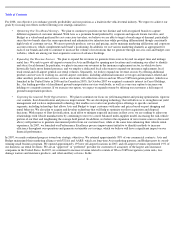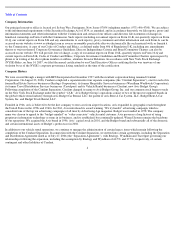Avis 2007 Annual Report Download - page 16
Download and view the complete annual report
Please find page 16 of the 2007 Avis annual report below. You can navigate through the pages in the report by either clicking on the pages listed below, or by using the keyword search tool below to find specific information within the annual report.
Table of Contents
computed on the basis of the length of the rental or, in some cases, on the length of the rental plus a mileage charge. Rates vary at different
locations depending on the type of vehicle rented, the local marketplace and competitive and cost factors. Rentals are made utilizing rate plans
under which the customer is responsible for gasoline used during the rental. We also generally offer our customers the convenience of leaving a
rented vehicle at a location in a city other than the one in which it was rented, although, consistent with industry practices, a drop-off charge or
special intercity rate may be imposed. We facilitate one-way car rentals between corporate-owned and franchised locations in the United States
that enable us to operate as an integrated network of locations.
Vehicle purchasing
. We participate in a variety of vehicle purchase programs with major domestic and foreign vehicle manufacturers. General
Motors is the featured supplier for Avis, and Ford is the featured supplier for Budget. During 2007, approximately 44%, 26% and 15% of the
cars acquired for our U.S. car rental fleet were manufactured by General Motors, Ford and Chrysler, respectively, compared to 42%, 32% and
12%, respectively, in 2006. During 2007, we also purchased Hyundai, Kia, Nissan, Subaru, Suzuki, Toyota and Volkswagen vehicles. The
decrease in the portion of our fleet sourced from Ford in 2007 is reflective of our overall efforts to diversify our fleet, which we expect to
continue in 2008. The substantial majority of vehicles used in our rental car business are purchased through our principal U.S. vehicle
financing program, which is an asset-backed facility.
Vehicle disposition . We generally hold a vehicle in our domestic fleet for a term of four to fourteen months. For 2007 and 2006,
approximately 75% and 88%, respectively, of the rental cars purchased for our domestic car fleet were subject to agreements requiring
automobile manufacturers to repurchase them or guarantee our rate of depreciation during a specified period of time. Cars subject to these
agreements are sometimes referred to as “program vehicles” or “program cars” and cars not subject to these agreements are sometimes referred
to as “risk cars” or “risk vehicles”. The programs in which we participate currently require that the program vehicles be maintained in our fleet
for a minimum number of months (typically four to twelve months) and impose return conditions, including those related to mileage and
condition. At the time of return to the manufacturer, we receive the price guaranteed at the time of purchase and are thus protected from
fluctuations in the prices of previously-owned vehicles in the wholesale market at the time of disposition. The future percentages of program
vehicles in our fleet will be dependent on the availability and attractiveness of manufacturers’ repurchase and guaranteed depreciation
programs, and we expect percentages for 2008 to be lower than 2007 as we acquire more risk vehicles in order to mitigate the anticipated
increased cost of program vehicles. We dispose of our risk vehicles largely through automobile auctions, including auctions that enable dealers
to purchase vehicles online more quickly than traditional auctions.
Of the approximately 407,000 cars from our rental car fleet that we sold in 2007 (compared to 445,000 that we sold in 2006), we sold
approximately 88% back to the manufacturers pursuant to repurchase or guaranteed depreciation programs and the rest through third party
channels such as wholesale auctions. In 2008, we expect the percentage of cars sold back to the manufacturers to decrease as we acquire more
risk vehicles.
Utilization and seasonality . Our car rental business is subject to seasonal variations in customer demand, with the summer vacation period
representing the peak season. The general seasonal variation in demand, along with more localized changes in demand at each of our locations,
causes us to vary our fleet size over the course of the year. For 2007, our average monthly fleet size in the U.S. ranged from a low of
approximately 300,000 vehicles in December to a high of approximately 388,000 vehicles in July. Our average fleet size increased 4.2% in
2007, to 340,899 vehicles. Domestic fleet utilization for 2007, which is based on the number of rental days (or portion thereof) that vehicles are
rented compared to the total amount of time that vehicles are available for rent, ranged from 68% in December to 79% in August and averaged
75% for 2007. Our calculation of utilization may not be comparable to other companies’ calculation of similarly titled statistics.
Maintenance
. We place a strong emphasis on vehicle maintenance since quick and proper repairs are critical to fleet utilization. To
accomplish this task we employ a fully-certified National Institute for Automotive Service Excellence (“ASE”) technician instructor at our
headquarters. This instructor has developed a specialized training
11
























